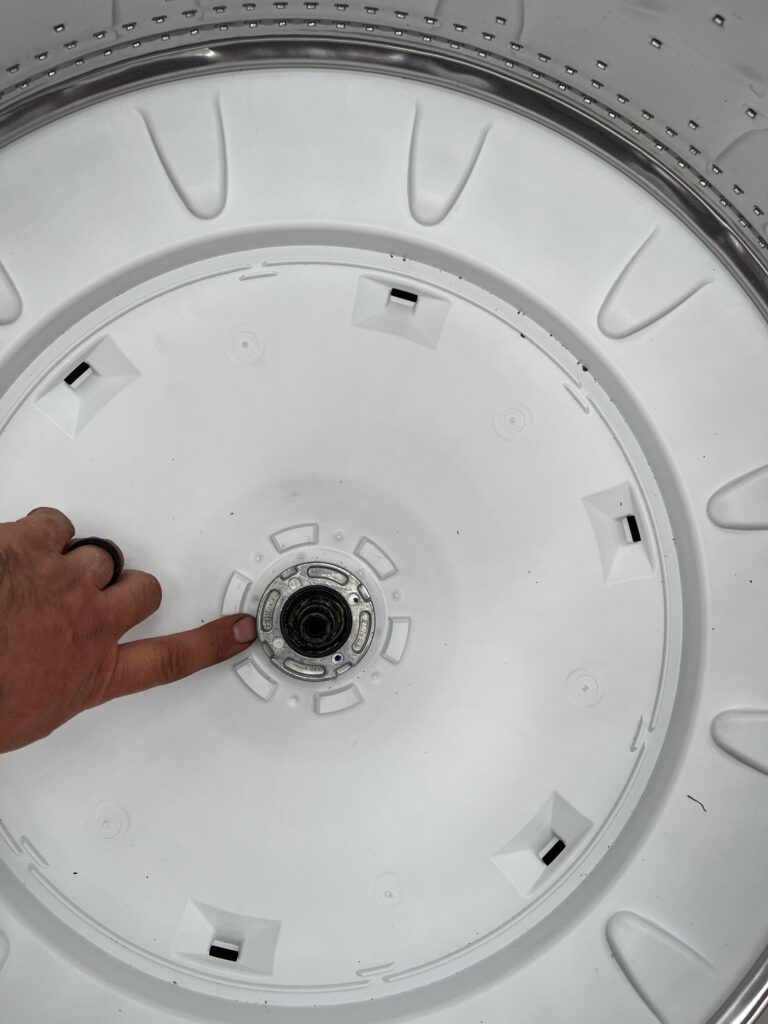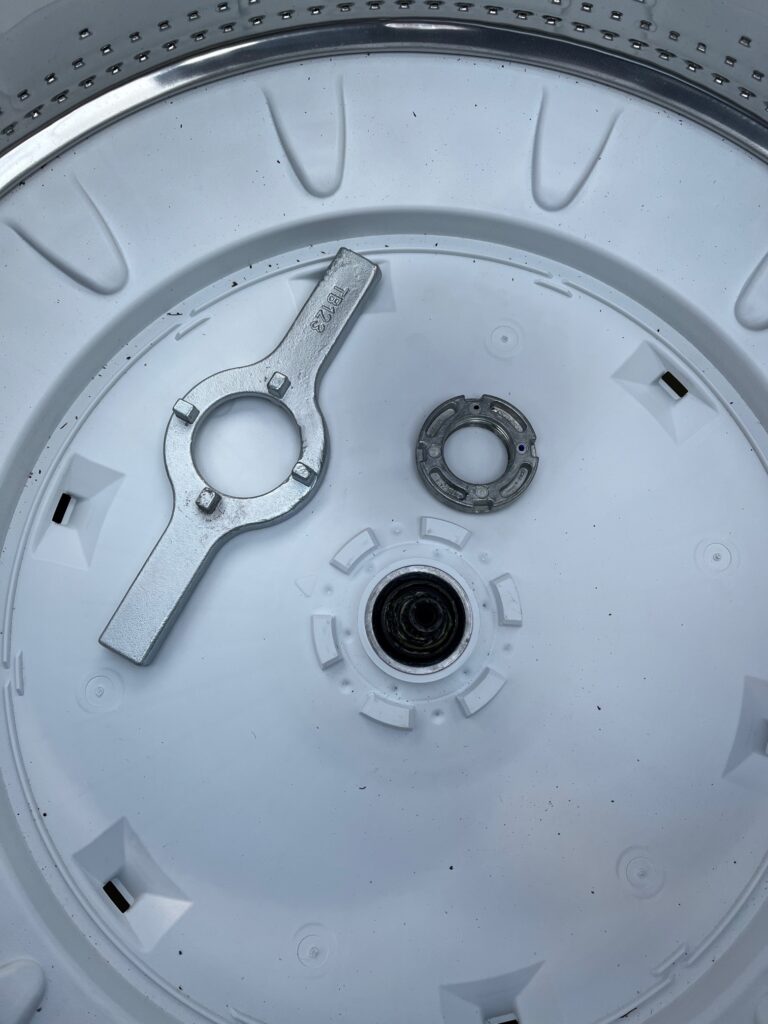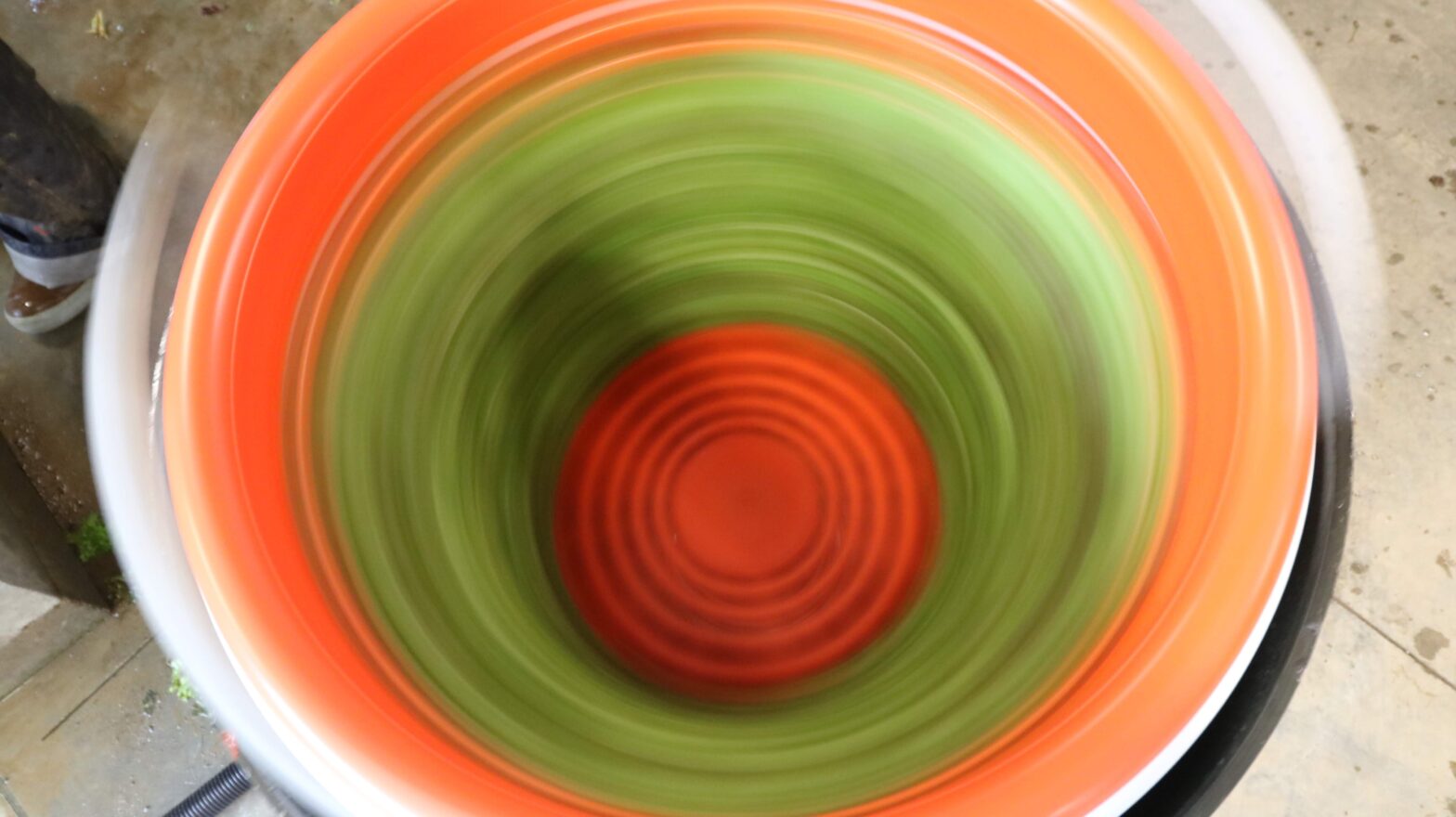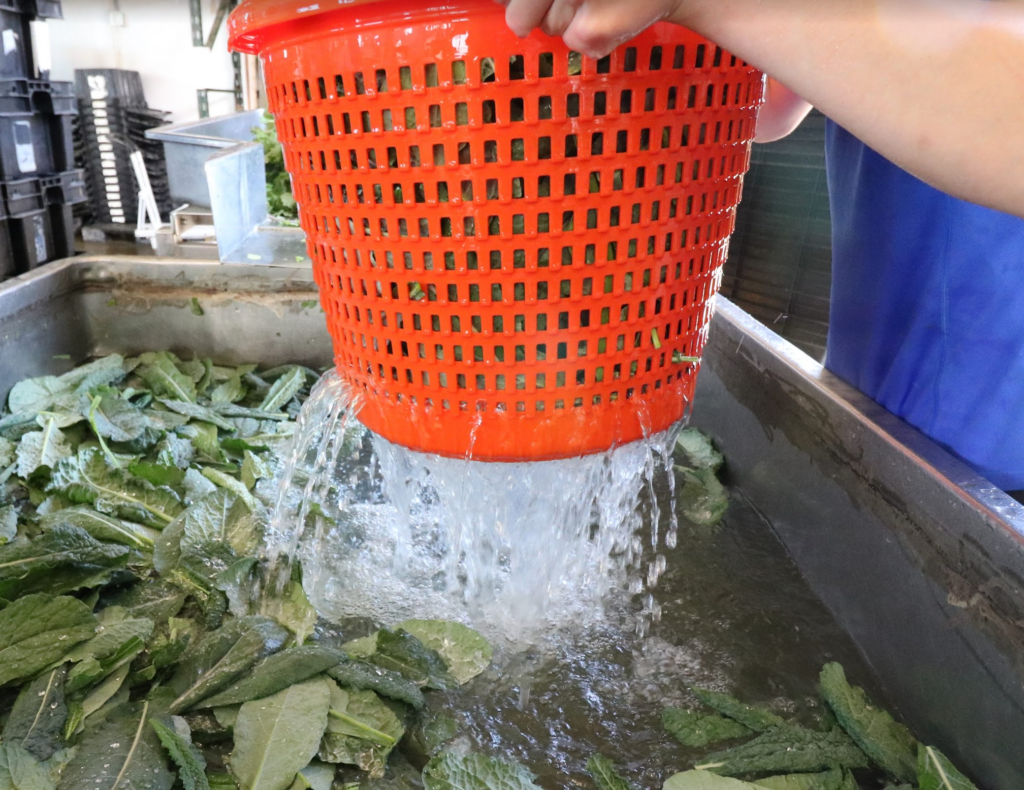Greens spinners play a vital role making greens production profitable for the small farm. Some farms find themselves stuck in the middle, where inexpensive, small-scale spinners cause a bottleneck, but it is hard to justify a more expensive industrial, stainless steel, restaurant-style machine. If you are just getting started, we have a full overview of Greens Spinners for Farm Use.
If you have decided to go with a washing machine conversion, then this post is for you. If you have the budget, we recommend that you start with a new machine. Starting with a new clean machine is best. If you are in the market for a washing machine we have a guide explaining the features that you should look for in our Shopping Tips post. Once you have chosen your machine use this post to walk you through the conversion process. We have developed standard operating procedures for washing machine conversions of three specific models.
Machine Specific Conversion SOPs
Whirlpool WTW500DW (Older model, hard to find)
Whirlpool WTW5010LW0 (Newer model that replaces the WTW5000DW)
Converting a washer we don’t have an SOP for? Here are some steps to help guide the way.
Key Points to Conversion
In this guide we cover three main objectives to the washing machine greens spinner.
Improving Hygienic design
When you are modifying a machine for food production you should keep in mind the five key principles of hygienic design which are:
- Visible and Reachable Surfaces
- Smooth and Cleanable Surfaces
- No Collection Points
- Compatible Materials
- Preventing Contamination
Adapting to fit basket inserts
We recommend the use of baskets for holding the greens inside of your spinner. These are used both for labor efficiency and ease of cleaning. By using a basket, it becomes the primary food contact surface, not the drum of the machine. Some modification may be necessary to fit baskets into some machines (including bumpers). Users who adopt the use of baskets find it efficient to “scoop” and drain their greens with them requiring less handling of the product.
Baskets are available from: Brookdale, Martins Produce Supply, Rainflow Irrigation, or Nolts Produce Supply. For a additional retailers visit our blog post on harvest containers.
Installation of a timer switch
The third key point to a conversion is installing a timer switch. This upgrade is the ticket to automating the machine to spin only, set a consistent cycle time between batches, and automatically shut off after a set amount of time.
Have the right mindset going into this project
Keep your produce safety glasses on during this procedure. This is a conversion from a household appliance to a machine used for handling food. If completed with appropriate attention to detail, a washing machine can be successfully converted into an appropriate machine for this use. If executed poorly by adding incompatible materials, increased harborage points, or resulting in insufficient cleaning, this may increase the risk of foodborne pathogens in your food.
Remember – The greens in this machine are likely to be eaten raw, so your primary food contact surfaces should be clean enough that you would want to eat off of them. With that in mind, let’s get started!
General Greens Spinner Conversion Procedures
Topics Covered:
Accessing and Stripping down the machine
Reading an Electrical Diagram
Electrical Conversion in General
Wiring the Timer Switch
Draining the Machine
Flitting the Basket
Tools
- Multimeter
- Socket set or nut drivers
- Flathead and Phillips screwdriver
- Wire cutters
- Needle nose pliers
- Channel-lock pliers
- Wire Strippers
- Wire Cutters
- Utility knife
- Hammer (or pry bar)
- Impact driver or drill
Materials
- Timer switch
- Wire nuts
- Electrical Tape
- Zip ties
- Waterproof electrical box
- ½ MNPT Cord Connector (2)
- Power cord (8’ of 14-3)
- 5/16” Self-tapping screws – to secure the switch to the body (2)
- 2.5” Corner bracket (1)
- Orange or White Baskets
- Bumpers for basket fit (6″ L x 3.5″ W x 3.5″ D)
- Spanner Wrench to remove some drums
Accessing and Stripping Down the Machine
The first step in a greens spinner conversion is to gain access to the machine and open it up to accept a basket, make it easier to reach into, and to open it up to promote drying. This is done by removing the top, back, or even side panels.
There are a few differences between how washers are built. Some are “chassis hung” from the top corners of the side panels and others are “bottom mounted”. Bottom mounted washers make it easier to remove that paneling so you can clean the machine easier and promote drying. This does make the unit appear smaller, but does expose the motor to water splashing and removes a location to mount the switch.
- Before removing anything first confirm that the machine spins. Make sure nothing is inside, plug it in and start the spin cycle. If the machine spins unplug the cord from the outlet and proceed.
- Use cardboard (or other protective material) to lay the machine on its back or side while working on it. This protects it from scratches which can lead to rust.
- The third step is to locate the electrical components that will be needed in the conversion.
- Capacitor – The Capacitor will be ~2” in diameter and ~6” long. It may be located on top behind the control panel, mounted near the motor underneath, or on the back wall of the appliance.
- Motor – The motor is a large block of metal which will have many copper windings. This will be on the bottom of the machine and have a belt or pulley attached to it.
- Pump – This will be connected to the drum and the back panel via a flexible rubber hose(s)
- Electrical Diagram – Some machines come with an electrical diagram either inside of the back cover, or taped to the side panel of a machine. If you can find this it will be helpful in determining what wires to tap into. ** If you do not find one – do not cut any wires until you complete the electrical testing procedure. **
4. Next, remove the access panel to promote drying. Generally the front or back is designed for easy removal.
Note: Some machine bodies are not designed to be taken apart and are attached via rivets. Do not attempt removal if this is the case.
5. Then, remove the top of the machine gaining access to the drum. The top may be connected via screws in the back, screwed on the front from underneath attached to the sides, or attached via spring clips. If this is the case, just pry carefully with a screwdriver or putty knife.
6. If you have located the wiring diagram the wires connecting the top to the bottom can be cut off. **Ensure the machine is unplugged** Make sure to keep the capacitor if it is installed on the top. Cut the appliance power cord as long as you can, this can be used again.
7. Remove the splash guard between the drum and the catch basin by prying or lifting the tabs or removing the ring/clamp.
8. Remove the agitator. Removing the cup up top can reveal a bolt, some models are just snug fit on a shaft. Other models will require cutting, to remove the agitator.
Reading an Electrical Diagram
Electrical drawings, also known as wiring diagrams or schematics, are just maps for electrical circuits. Some people find it helpful to think of electrical circuits like plumbing or irrigation systems. Current flows from a high to low voltage similar to how water flows from high pressure (or higher elevation) to low pressure (or lower elevation).
Finding the Wiring Diagram
Before you can read the diagram, you need to find it. The wiring diagram is sometimes attached to the washing machine enclosure or tucked in an envelope on the inside of a panel. Your machine may not have one attached to it. Using the make and model information and the words “wiring diagram” in an internet image search could help finding the diagram. Below are some examples of what they look like.
Making Sense of the Wiring Diagram
Whoa! There is a lot of stuff there, right? We only really care about a few key things.
Just like any other map, it is helpful to use landmarks to get oriented. The key landmarks are:
- The plug – where the power comes from.
- The motor – what we need to power to make the drum spin.
- The start capacitor – which is needed to overcome the starting torque of spinning the drum.
Once you realize that you are only really looking for these three things, you realize there is a lot of other “noise”in the schematic that is distracting for our purposes.
Using the same wiring diagrams as above, let’s find the landmarks.
The other important thing to pay attention to is wire color. This is very helpful in translating between the schematic and the actual wiring on the machine. For example, if you find the motor on the machine (pretty easy) and then find a red wire, you can usually follow that to the start capacitor.
Wire color is noted on schematics with a letter designation. Most commonly:
- B or BK = Black
- W = White
- G or GN = Green
- BL or BU = Blue
- Y or YEL = Yellow
- R = Red
- O or ORN = Orange
- BN = Brown
- W/GN = Green with a White Stripe
- Y/BK = Black with a Yellow Stripe

Electrical Conversion in General
A washing machine does a number of things when used for washing clothes that require the machine to run in different modes. These different modes introduce lots of electrical components and controls that we don’t need for using the machine as a greens spinner. All we need to do is run the motor on the spin cycle, which is simply putting power to the start capacitor which is inline with the start coil. A centrifugal switch attached to the motor engages when the drum is spinning at the right speed and switches the power over to the run coil.
This means we are going to ignore and possibly remove much of the electrical system designed into the washing machine. Removing it can be helpful when trying to achieve a cleanable assembly that applies hygienic design principles.
In the most simple form, all we need to do is put a switch or a timer switch between power and the start capacitor as shown below.
Electrical Conversion Wiring
At this point, you should have the wiring diagram in hand. A few other tools will be helpful:
- Multimeter / voltmeter
- Wire snips for cutting wires
- Wire stripper for removing insulation
- Wire nuts for connecting wires
- Electrical tape for wrapping loose ends and wire nut connections
- Screwdriver
General Approach
NOTE: Review electrical safety and take steps to avoid contacting live electrical lines. Confirm that main power is disconnected and voltage is not on any line you are planning to contact for wiring.
- Locate Main Power Wires. Trace the main power from the wall plug to the main control board.
- Note the wire bundle, specific wires, wire colors and/or wire surface texture you will need based on the wiring diagram.
- L1 – 120 VAC power
- N – Neutral
- GND – Ground (this may go directly to the frame or chassis)
- There may be a connector that can be disconnected.
- Note the wire bundle, specific wires, wire colors and/or wire surface texture you will need based on the wiring diagram.
- Locate Motor. Find the motor
- You may want to put the machine on its back, or remove panels to have better access and visibility.
- Trace the motor wires back from the motor.
- Note the wire bundles and colors you plan to use based on the wiring diagram.
- Locate Capacitor. Find the capacitor
- On some models the capacitor is attached to the motor.
- On other models the capacitor is attached behind the control panel where the cycle selector knob is.
- Confirm the wire colors coming off of the capacitor.
- Label the wire that goes from the capacitor to the motor.
- Check the Diagram. Return to your wiring diagram and check what you found.
- Does each wire color match what you would expect from the diagram?
- Can you trace each wire on the diagram that you found on the machine?
Wiring the Timer Switch
- Once you have identified which wires you need for your switch, take the wires coming from the motor/capacitor and cut them about 8 inches long, these are the ones you need to connect to the switch.
- Any wires identified that are not needed can be folded over and taped to prevent the conductors inside from contacting each other, water, or a metal surface.
- Cut off 8 feet of electrical plug wire.
4. Strip the wires from one end of the cord and the three wires going to the motor.
5. Connect the wires identified to the electrical cord using wire nuts.
- Turn the machine upright and mount electrical box to the side of the appliance that is desired using a 2.5” corner bracket to angle it for easy of use with 1⁄4” self-tapping screws.
- Using one of the 5/16” screws previously removed, attach the corner bracket to the electrical box through one of the knockout screw holes. (use a hammer to break the bump out) If the screws is loose, mark the holes and drill a smaller pilot hole in the box and use self tapping screws.
- Install the cord fittings to the waterproof box and insert the cord from the motor wires, and the appliance power cord into the box, do not pinch the wire down in the connector just yet.
- Wire in the Switch
- Using a multimeter Identify which side of the power cord is neutral (white)
- Tip: The neutral side often has lettering, ribbing, or the larger plug on that leg of the cord. To test connect one lead of your multimeter to ground and use the other multimeter lead to test the other two wires when plugged in. The wire with a reading (110-120 VAC) is hot (black) the reading with nothing is neutral (white)
- Use a 6” piece of wire from to use as a jumper.
- Strip the ends of both cords and wire in the switch.
- White to White
- Black from power into one side of the switch, black to motor from other side of the switch.
- Both green grounds, the switch ground and the jumper go together.
- Connect the jumper to the screw in the box.
- Using a multimeter Identify which side of the power cord is neutral (white)
- Carefully install the knob, connect power and test for spinning!
- If all works, disconnect power and carefully tuck wires into the box and mount the switch.
- Snug both wire connectors around the wire.
- Install the faceplate.
- Lay the machine back down and begin to wrap the wires from the motor with electrical tape. Wrap each wire nut individually.
- Next add the second then the third to keep them separated and to create a strong and sealed connection.
- Carefully loop this cable to not strain or kink any of the wires and secure with zip ties back to the machine using one of the previous tabs of the wiring harness.
- Use zip ties to secure the rest of the wire to the side panel of the chassis through the previous screw holes.
- Electrical is complete!
Draining the machine
It is important that the drum has a proper drain so it directs water away from electronics. This can be done one of two ways.
- You may be able to bypass the pump entirely and connect a flexible hose to the bottom of the drum to direct water away from the machine.
- Some drums do not have a good flange and need to flow through the pump to the drain hose, this can be ok if you verify that the pump spins during the spin cycle and/or water flows freely and does not back-up into the machine.
Basket Fit
If you are using an orange basket to wash your greens you may need to do some modifications in order to make it fit snuggly. Some drums fit the orange baskets just fine, and others will fit the white 20 gallon drums better. The white drums may be too tall depending on your machine.
You want to avoid screwing into the upper plastic ring of the drum as it is fluid filled and used to help balance the load. Following are a few ways around screwing in a spacer.
Removing a Drum Secured with a Nut
Removing the drum is important for deep cleaning, if you’ve dropped something into it or desire to install bumpers to secure the basket (more info below on that). Some model machines use a plastic key used to secure the drum to the shaft while others require a spanner wrench to remove the special nut. These can be found on Amazon or eBay by searching for “washing machine spanner wrench“. A handy tool for <$20 to made maintenance simple.


Installing Bumpers
You can install some bumpers via bolts to secure the load. In order to modify the drum, you must first remove it from the washer. You will need 6 of the following: 2-1/2″ 5/16 hex head cap screw, 5/16″ flat washers, 1/2″ plastic or metal spacer, 5/16″ nut.
Newer machines often have a drum that is designed to be removed. First by removing the agitator or wash plate then by removing a nut or a key. If your drum has a nut you may need a specific wrench in order to remove it.
- Remove the drum by removing the cap, 11 mm bolt and plastic key under the wash plate.
- Align the bumper positions up with the wash plate and mark the location of the holes to mount the bumpers. Drill a 5/16” hole in each location. These need to be equally spaced in order to keep the drum in balance.
- Install the bolts from the outside of the drum, then add 1/2” spacer, bumper, washer and the nut inside the bumper.
Share this post!
go.uvm.edu/generalspinnerguide


